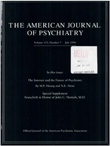Restraint and seclusion: a review of the literature
Abstract
OBJECTIVE: The author reviewed the literature published since 1972 concerning restraint and seclusion. METHOD: The review began with a computerized literature search. Further sources were located through citations from articles identified in the original search. RESULTS: The author synthesized the contents of the articles reviewed using the categories of indications and contraindications; rates of seclusion and restraint as well as demographic, clinical, and environmental factors that affect these rates; effects on patients and staff; implementation; and training. CONCLUSIONS: The literature on restraint and seclusion supports the following. 1) Seclusion and restraint are basically efficacious in preventing injury and reducing agitation. 2) It is nearly impossible to operate a program for severely symptomatic individuals without some form of seclusion or physical or mechanical restraint. 3) Restraint and seclusion have deleterious physical and psychological effects on patients and staff, and the psychiatric consumer/survivor movement has emphasized these effects. 4) Demographic and clinical factors have limited influence on rates of restraint and seclusion. 5) Local nonclinical factors, such as cultural biases, staff role perceptions, and the attitude of the hospital administration, have a greater influence on rates of restraint and seclusion. 6) Training in prediction and prevention of violence, in self-defense, and in implementation of restraint and/or seclusion is valuable in reducing rates and untoward effects. 7) Studies comparing well-defined training programs have potential usefulness.
Access content
To read the fulltext, please use one of the options below to sign in or purchase access.- Personal login
- Institutional Login
- Sign in via OpenAthens
- Register for access
-
Please login/register if you wish to pair your device and check access availability.
Not a subscriber?
PsychiatryOnline subscription options offer access to the DSM-5 library, books, journals, CME, and patient resources. This all-in-one virtual library provides psychiatrists and mental health professionals with key resources for diagnosis, treatment, research, and professional development.
Need more help? PsychiatryOnline Customer Service may be reached by emailing [email protected] or by calling 800-368-5777 (in the U.S.) or 703-907-7322 (outside the U.S.).



